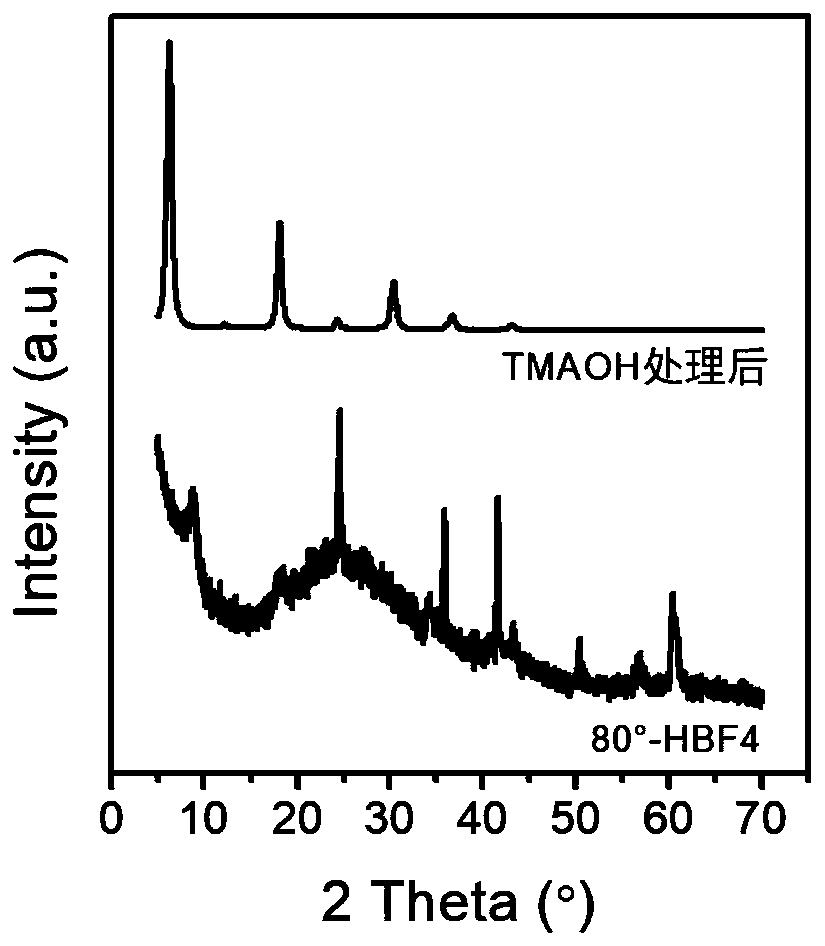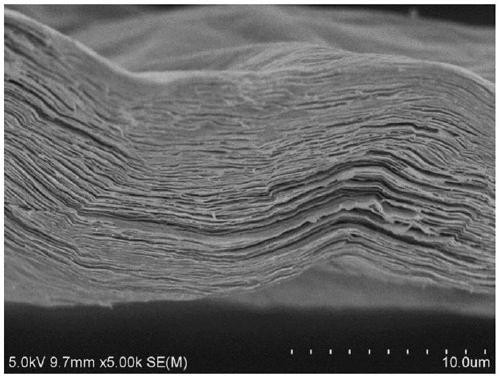Two-dimensional transition metal carbonitride as well as preparation method and application thereof
A technology of transition metals and carbonitrides, applied in the field of two-dimensional materials, can solve the problems of the influence of electrochemical properties of materials, production equipment and high environmental safety requirements, and achieve high specific capacitance, good rate performance and broad prospects
- Summary
- Abstract
- Description
- Claims
- Application Information
AI Technical Summary
Problems solved by technology
Method used
Image
Examples
Embodiment 1
[0036] 1 g MAX phase material Ti 3 AlC 2 Adding 40ml mass fraction is 40wt% HBF 4In the aqueous solution, stir at 80° C. at a speed of 400 rpm for 24 hours, then repeatedly centrifuge and wash with water until the pH of the solution is greater than 5, and obtain an etching product;
[0037] Subsequently, the etching product was added to 10 mL of tetramethylammonium hydroxide (TMAOH) aqueous solution (25 wt %), stirred at 25 °C at a speed of 500 rpm for 24 h, then repeatedly washed with water until the pH of the solution was less than 9, and 100 g of water was added Afterwards, Ti was stably dispersed in water by shaking by hand. 3 C 2 T s ; take the upper black uniform liquid vacuum filtration, after natural air-drying, separate from the filter membrane to obtain Ti 3 C 2 T s film.
[0038] During the reaction Ti 3 AlC 2 and HBF 4 The intermediate etching product (80°-HBF 4 ) XRD spectrum and Ti obtained after TMAOH post-treatment 3 C 2 T s The XRD spectrum of t...
Embodiment 2
[0042] Same as Example 1, but HBF 4 The temperature of the aqueous solution is changed to 50°C, and the other steps are the same, and a stable dispersed two-dimensional Ti can also be obtained. 3 C 2 T s Dispersion, the dispersion is freeze-dried to obtain Ti 3 C 2 T s Powder; the dispersion can be obtained by suction filtration 3 C 2 T s film. HBF in this example 4 Material after aqueous treatment (50°-HBF 4 ) XRD patterns and freeze-dried Ti 3 C 2 T s The XRD spectrum of the powder is shown in Figure 4 . Ti 3 C 2 T s The scanning electron microscope image of the thin film is shown in Figure 5 . From the obtained XRD spectra, SEM images and the fact that a black dispersion liquid stably dispersed in water can be obtained, it can be confirmed that the two-dimensional Ti 3 C 2 T s Material.
PUM
 Login to View More
Login to View More Abstract
Description
Claims
Application Information
 Login to View More
Login to View More - R&D
- Intellectual Property
- Life Sciences
- Materials
- Tech Scout
- Unparalleled Data Quality
- Higher Quality Content
- 60% Fewer Hallucinations
Browse by: Latest US Patents, China's latest patents, Technical Efficacy Thesaurus, Application Domain, Technology Topic, Popular Technical Reports.
© 2025 PatSnap. All rights reserved.Legal|Privacy policy|Modern Slavery Act Transparency Statement|Sitemap|About US| Contact US: help@patsnap.com



